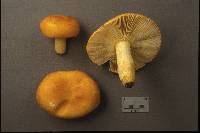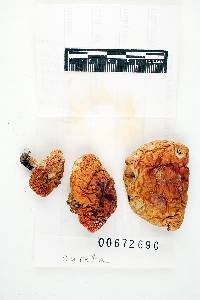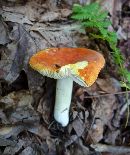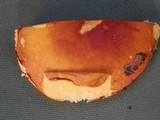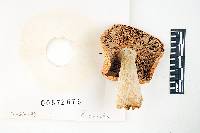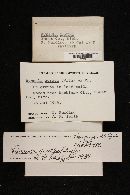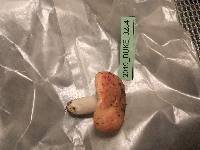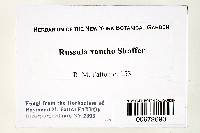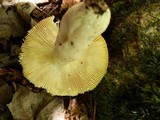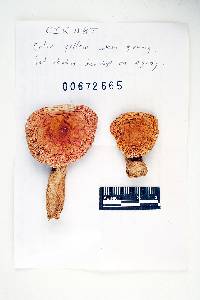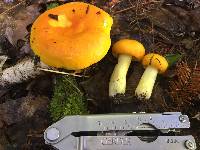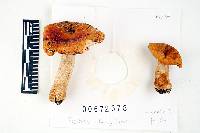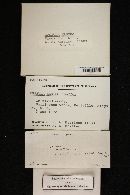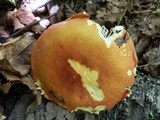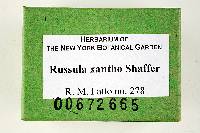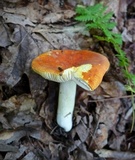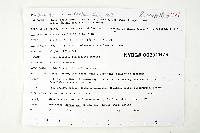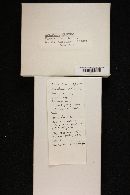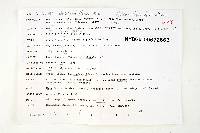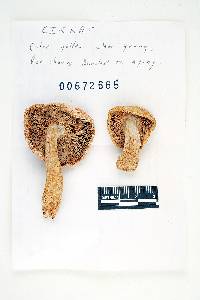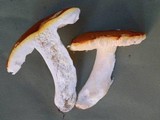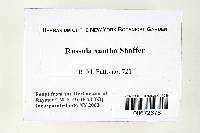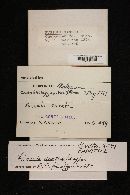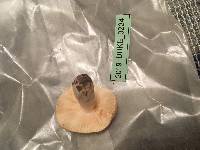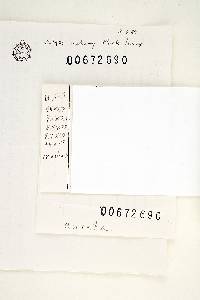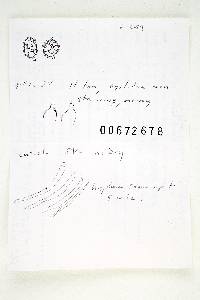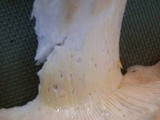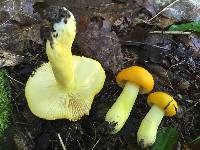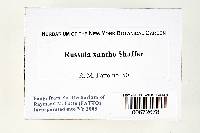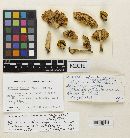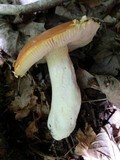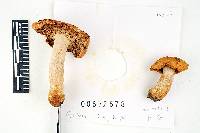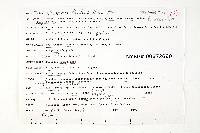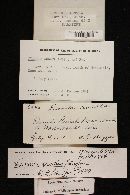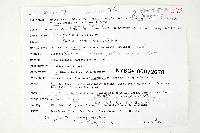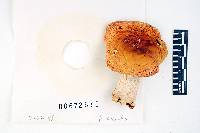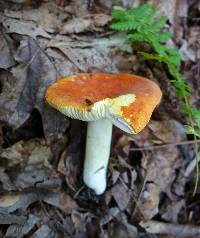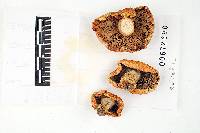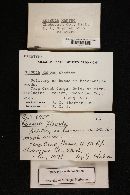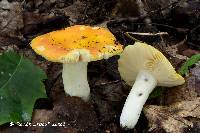
|
|
|
|
Family: Russulaceae
|
Russula xantho Shaffer, sp. nov.: Russula xantho Shaffer, sp. nov.— Type: west of Mackinaw City, Emmet Co. , Michigan, 29 Jul 1968, Shaffer 6067 (holotype: MICH!). Figs. 16-19. Fructificatio mediocris. Pileus margine subtiliter striatus; cuticula glabra, insapora, lutea, ad centrum aurantiaca; trama firma fragilisque, sapore non aero, odore indistincto, albida vel luteola, nonnunquam lutea vel aurantiaca sub cuticula, tarde cinerascens, ope sulfovanillinae incolorata. Lamellae fragiles, versus ambitum rotundatae, adnatae vel adnexae, confertae, sapore indistincto, stramineae, nonnunquam luteomarginatae, nonnunquam leviter cinerascens. Stipes totus albidus vel supra luteus, leviter cinerascens. Sporae in cumulo luteolae, 6.8-9.7 (-10.7) X 6.3-7.9 um (ornamentatione exclusa), verrucis et cristis usque ad 0.7-1.2 um altis et connectivis, ornamentatione reticulum inchoatum vel integrum saepe formanti. Subcutis pilei ex hyphis conjunctivis intertextis et hyphis vascularibus rarissimis constans. Epicutis pilei trichodermium formans, ex hyphis conjunctivis cellulis interdum inflatis vel cystidioideis et pseudocystidiis rarissimis constans. Pileus 4.5-8 cm broad, subglobose when young, expanding to deeply pulvinate and eventually plano-convex with a depressed disc, becoming finely tuberculate-striate 3-6 mm from the edge inward; cuticle thin, viscid to almost dry, shiny to subshiny, glabrous, separable 2/3 the pileus radius, tasteless, when young unevenly deep orange, strong orange yellow, and vivid yellow overall, when mature deep orange centrally and vivid to strong yellow marginally; trama 2-3 mm thick at mid-radius, firm-brittle, with a faintly spermatic taste and a slight, nondescript odor, sometimes tinged yellow to orange just beneath the cuticle, otherwise buffy white to pale yellow, slowly (e.g., overnight) cinerescent where cut. Lamellae 6-8 mm broad, brittle, equal, rounded in front, adnate to adnexed, close, occasionally forked at or near the stipe, intervenose, entire to finely lacerate, with a mild, nondescript taste, pale yellow at first, becoming light yellow, sometimes edged with strong yellow, unchanged or slightly dingy in age. Stipe 4-9 cm long, 12-20 mm thick, equal or enlarging to the base, dry, dull, glabrous, longitudinally rugulose, stuffed, buffy white below and strong yellow above (i.e., on the portion originally in contact with the lamellar edges), or buffy white overall, slightly cinerescent in age or when handled. Color reactions on the pileus trama: SV colorless; 10% FcSO, grayish yellowish pink; 2% phenol dark grayish reddish brown; formalin colorless; guaiac slowly greenish gray. Spores light orange yellow (M&P 9G5) in mass; 6.8-9.7 (-10.7) x 6.3-7.9 um, usually broadly elliptic to broadly obovate, occasionally subglobose; ornamentation of warts and ridges, both up to 0.7-1.2 um high, and connectives, often forming a partial or complete reticulum; suprahilar area with low ornamentation varying from closely spaced warts, ridges, and connectives to an uneven, diffuse patch, and in most cases appearing as strongly amyloid as the ornamentation on the rest of the spore wall. Basidia 25-59 x 8-15 um, clavate, 4- or rarely 2-spored. Hymenial pseudocystidia 36-86 x 6-15 um, usually fusiform, sometimes fusoid-clavate, clavate, lanceolate, or even subcyhndric, rounded to acute or capitellate, mucronate, or appendiculate apically, empty or with weakly SV+ contents, arising in the subhymenium usually at lower levels than the basidia, projecting up to 40 um beyond the basidioles, common to abundant. Lamellar edges sometimes bulbous in section and then with few or new basidia, the component hyphal ends sometimes relatively undifferentiated in shape and contents, but usually with short subapical cells and terminated by either a pseudocystidium, whose size generally falls in the lower part of the range given above, or a leptocystidium, which may be clavate, fusoid-ventricose, tapered, fusiform, or irregular in shape. Subhymenium 23-40 um thick, pseudoparenchymatous. Trama with occasional, SV- glassy vascular hyphae, and rare, inconspicuous, SV- or weakly SV+ granular vascular hyphae. Pileus subcutis 135-270 um thick, dense, of horizontal-interwoven, nongelatinous connective hyphae 1-5 um broad, these hyphae with diffuse orange yellow pigment, also with rare SV- glassy vascular hyphae 1-5 um broad. Pileus epicutis 50-60 um thick, embedded in a gelatinous matrix, a well-formed trichoderm of nongelatinous, septate, branched connective hyphae whose subapical cells may be inflated to various degrees (up to 9 um broad) and whose apical cell is sometimes cystidioid in shape (tapered, lanceolate, fusiform, oval, clavate, narrowly fusoid-ventricose), at times capitellate, and occasionally with scattered small refractive bodies; also with rare elongate-clavate pseudocystidia 4-5 um broad which arise usually in the subcutis and have sparse refractive contents that are at most weakly SV+. Stipe surface layer of longitudinal-interwoven, nongelatinous, hyaline to yellowish connective hyphae 1-5 um broad whose cystidioid terminal cells often project from the stipe surface, may be scattered or clustered, and may be SV-, clavate pseudocystidia; also with SV- vascular hyphal ends 3-7 um broad which grade into the pseudocystidia. Solitary to gregarious on humus usually in deciduous (e.g., beech-maple) woods. Specimens Examined: Canada. Nova Scotia: Kings Co.: Harrington Woods, Kentville, 3 Aug 1972, Harrison J1683.—V.S.A. Michigan: Cheboygan Co.: Carp Creelc Gorge, 7 Aug 1961, Charlton G294, and 1 Aug 1973, Shaffer 6955. Emmet Co.: W of Mackinaw City, 25 Jul 1949, Harding s.n. and 29 Jul 1968, Shaffer 6067 (holotype of R. xantho Shaffer). Wisconsin: Dunn Co.: Devil's Punch Bowl, south of Menominee, 4 Jul 1971, Mazzer 6542. The species epithet, from Greek, refers to the pileus cuticular color; Xantho was the golden-haired daughter of the sea-god Nereus. By some American mycologists this species has been called R. aurata (With.) Fr., to which it is close. However, R. aurata as described by Romagnesi (1967), and studied by me in Europe (e.g., Shaffer 4033, 4069, 4235, and 4595), has pilei that are partly or entirely dark reddish orange to dark grayish reddish brown or grayish red. Often they are also partly strong orange-yellow to strong yellow, but, even when mostly these colors, they have small reddish areas as shown in Schaeffer's (1952) pi. 11, fig. 37. The slight cinerescence of the basidiocarp and the presence of a few inconspicuous pseudocystidia in the pileus cuticle, neither mentioned by Romagnesi for R. aurata, may be other, minor differences. Schaeffer, however, described the trama of this species as "etwas schmutzend." The yellow to orange tinge of the pileus trama just beneath the cuticle, the strong yellow edging of the lamellae, and the strong yellow coloration on the stipe have sometimes been emphasized as diagnostic characteristics of R. aurata, but are actually inconstant in both this species and R. xantho. Russula aurata and its allies have been variously placed within sect. Russula, most recently by Singer (1986) in subsect. Firmiores. |
|
|
|



